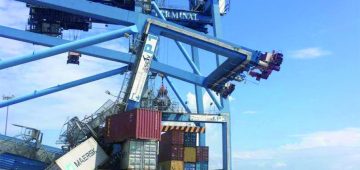CMA CGM reported a consolidated net income of $86m in the first quarter of 2017, a significant rebound from a net loss of $100 million posted in the first quarter of 2016 suppressed by pressured freight rates. During the quarter, volumes carried marked a strong increase of 34.2% in comparison to the first quarter of 2016, thanks to the integration of APL. According to CMA CGM, for the first time, and less than a year after its acquisition, APL has contributed positively to the group’s results. Specifically, it achieved a gross operating income of $56 million and its net result was a profit of $26m. The group’s consolidated revenues were up by 35.9% in comparison with the same period of 2016, standing at $4.6 billion.
Deltamarin’s energy-efficient cargo ship family has reached yet another milestone as Icelandic Eimskip Ltd. and Greenland-based Royal Arctic Line A/S ordered the first three container vessels based on Deltamarin’s design. The ships will be built at the Guangzhou Wenchong Shipyard in China, with which Deltamarin (China) Co. Ltd. has signed a design contract. Deltamarin earlier developed the vessel concept for the two ship owners to fit their trading routes. The 180m long and 31m beam ships are designed to achieve the best possible key performance indicators, such as container carriage variety, homogenous loading capacity, optimal manoeuvrability and harsh weather seakeeping performance. The highly fuel-efficient and environmentally-friendly 2,150 TEU capacity container vessels are capable of sailing even in Arctic waters. They will have an ice class and comply with the newly adopted IMO Polar Code. The work will be carried out at Deltamarin’s Shanghai office in China over an estimated period of eight months.
Euroseas Ltd. has signed a memorandum of agreement to purchase the EM Astoria, a 30,024gt/2004-built feeder-size containership. Featuring a capacity of 2,788 TEUs, the vessel is to be acquired at market price from Euromar LLC, the company’s joint venture with two private equity firms. Delivery was expected to Euroseas in June 2017.

Hapag Lloyd’s merger with the United Arab Shipping Company (UASC) was concluded on 24th May. The merger was completed in Hamburg some 10 months after the business combination agreement (BCA) was signed between the two container lines. The merger was originally scheduled for completion on 31st March 2017 but the process ran into complexities with the documentation so the deadline was deferred. The combined company is the world’s fifth largest container line with 230 vessels with a total capacity of 1.6m TEU. Qatar Investment Authority and the Public Investment Fund of Saudi Arabia have subsequently become key shareholders in Hapag-Lloyd with 14.4% and 10.1% stakes respectively. Alas the merger will mean the loss of around 1,000 jobs.
Mitsui O.S.K. Lines’ MOL Triumph made her maiden call at Hamburg on 15th May, berthing at the HHLA Burchardkai Container Terminal. The new Mitsui O.S.K. Lines (MOL) flagship was the first vessel with a loading capacity of over 20,000 TEU to visit the Port of Hamburg. Sailing under THE Alliance shipping consortium, like her sister-ships, the MOL Triumph is deployed in the FE2 service between Asia and Europe. The FE2 offers a fast direct service between China and SE Asia with the western Mediterranean and northern Europe. For example, the transit time eastbound between Hamburg and Hong Kong lies around 33 days, westbound between Singapore and Hamburg 24 days. MOL has also announced that an average 2% reduction in overall carbon dioxide emissions has been achieved in live tests of its containership “windshield” technology first unveiled by the company in 2015. The in-service demonstration of the windshield, which was co-developed by MOL, was carried out aboard the MOL operated and 78,316gt/2010 built MOL Marvel. According to MOL, the test confirmed about a 2% average reduction in CO2 emissions while sailing at 17 knots after the windshield was installed on the bow of the ship. The 2% reduction is compared to operating an identical vessel at the same speed without the device installed. The containership windshield was developed as part of MOL’s “Ishin Next – MOL Smart Ship Project” that seeks to develop and introduce new technologies that will reduce vessels’ environmental impact.
Sign-up today to read the full article!
Simply click below to sign-up and read the full article, as well as many others, instantly!






Comments
Sorry, comments are closed for this item